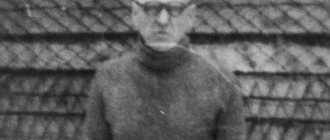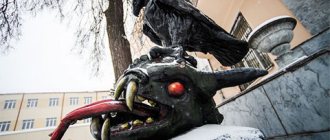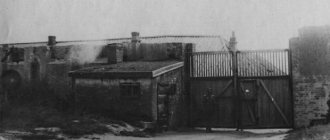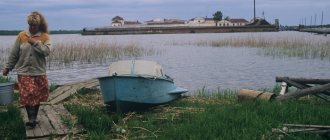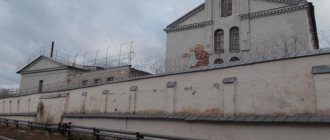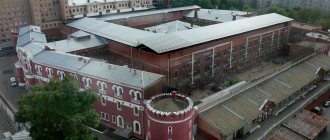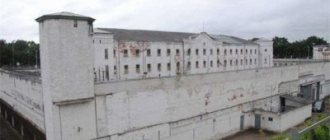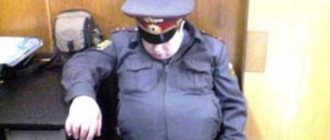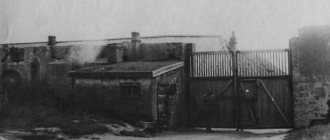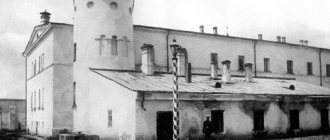Lenta.ru continues a series of publications about special regime colonies - the most terrible zones in Russia. There, in extremely harsh conditions, the most dangerous criminals are serving life sentences - from maniacs and cannibals to terrorists and creators of criminal gangs. In the previous article we talked about the Black Dolphin colony in the Orenburg region, and this time we will talk about the White Swan colony in the Perm region. Once upon a time, thieves in law were “broken” here, but today they are holding life-sentenced prisoners. They are separated from society by 15 security lines, 500 guards, 50 service dogs and guards who are ready to shoot to kill if they try to escape. Most will remain in the White Swan until the end of their days - and on the graves instead of a name there will be a number from a prison uniform.
Breaking thieves
In 1955, Usollag was abolished and in its place a regular colony for criminals appeared. In the early 80s, the correctional institution set a course for an active fight against the caste of thieves in law, which was annoying the authorities. The authorities were specially taken to Solikamsk, where they began to be painstakingly and mercilessly “processed.” This treatment took place inside a single chamber-type room (EPKT), which was specially erected on the territory of the colony as an experiment.
Various methods were used to “break” thieves - from outright intimidation and beatings to the use of all sorts of cunning moves. For example, after a medical examination, an authority figure could be told that he had been diagnosed with cancer, but in order to begin treatment, he would have to renounce his title as a thief. Or a particularly stubborn thief could be placed in a cell with “bitches,” renegades from the world of thieves who agreed to cooperate with the prison leadership. And the “bitches” were already trying to get their new neighbors to renounce their thieves’ titles.
According to unofficial data, over almost half a century more than 130 thieves in law have lost their titles in the White Swan. Vladimir Babushkin (Vasya Brilliant), a real legend of the world of thieves, who ended up in the colony, did not lose his title, but disappeared in the “White Swan” in 1985. Despite the fact that, according to the official version, the death of the authority was not violent, admirers of Vasya Brilliant are sure that he was killed for disobedience.
Thief in law Vladimir Babushkin (Vasya Brilliant)
Photo: Prime Crime
History of the colony, why the prison is called “Polar Owl”
Until the sixties of the last century, this place on the banks of the Sobi River was a typical wasteland of the polar Urals. Then the builders founded the closed village of Kharp here. It was inhabited not by inveterate robbers, but by ordinary citizens whom the Soviet government, for one reason or another, considered inconvenient for itself. They built a colony here for the “especially dangerous”.
In 1981, it became an ordinary correctional institution and remained in this status for twenty-three years, when the new government of the renewed state again made it the last refuge for outcasts of society.
Why this place is called that becomes clear immediately - outside the gate, newcomers are greeted by a huge statue of a white owl, preparing to grab its victim.
On the one hand, this is connected with nature, but also this bird symbolizes the newcomer’s meeting with the other world, which will take place here. He will hope for parole, like all criminals, not knowing that death is already chasing him and the realization of its approach will come too late, it will strike like the claws of a polar predator.
Swan song of prisoners
In 1999, the correctional institution was repurposed as a colony for life prisoners and received the official name - correctional colony No. 2 (IK-2) of the association of correctional colonies No. 2 (OIK-2) of the Federal Penitentiary Service (FSIN) in the Perm Territory. In October of the same year, the first 24 “lifers” arrived at the White Swan. They were placed in the EPKT, where thieves in law were previously “broken” - even during the initial design, all the cells in the room were equipped with strong double doors.
Solikamsk OIC-2, in addition to the White Swan itself, also includes correctional colony No. 1 (they have a common address). But, unlike IK-2, in IK-1 there are not life-sentenced prisoners, but ordinary prisoners with long terms of imprisonment. In addition, there are two colony settlements located near the White Swan.
Photo: Ruadvocate.ru
There are several versions of how IK-2 got its romantic “swan” name. According to one of them, the correctional facility was originally built in a clearing that local residents called the “White Swan.” According to another version, even during the break-up of thieves in law, the gates of the zone were decorated with figurines of swans - that is why this gloomy place began to be associated with noble birds. Finally, according to the third version, there are two white buildings on the territory of IK-2, and the curved paths leading to them resemble swan necks.
However, the prisoners themselves, who are in the colony, believe that the whole point is in the strict regime of detention, because of which their existence can be compared to a “swan song”. According to popular belief, it marks the end of the life of swans. However, there is one more, perhaps the most prosaic explanation. Prisoners are led around the territory of the colony bent over, with their arms shackled and pulled back - and their pose themselves somewhat resembles swans.
Be that as it may, over time the name “White Swan” has become a real prison brand of IK-2: convict craftsmen are actively making various things with a swan theme. For example, weather vanes, trash cans that prison authorities install on the territory, or wooden napkin holders in the shape of swans.
Life of special regime
Now in OIC-2, out of two and a half thousand convicts, there are about 300 “lifers”. They employ about 500 prison staff and 50 specially trained dogs. Jailers who want to get a job at the White Swan undergo a very strict selection process. They must have a higher education, good health, resistance to stress and an impeccable biography - not only for the applicant himself, but also for his immediate relatives.
In the White Swan cells, prisoners who received life sentences sit in groups of one, two or even three. Their compatibility is determined by a psychologist. For example, the Chechen field commander Salman Raduev was sitting with a former special forces officer: despite the fact that in the wild these two were supposed to become irreconcilable enemies, in the prison dungeons, as the psychologist had predicted, they were able to coexist quite peacefully.
Salman Raduev
Photo: Anton Denisov / TASS
In general, the daily routine of convicts in the White Swan is not much different from the routine in the Black Dolphin, the oldest Russian colony for lifers. General wake-up is at 6:00, followed by breakfast; Prisoners eat only in their cells. After breakfast, there is cleaning: all the belongings of the White Swan prisoners must be in a certain order, and there are cloth drawers in the cells for clothes.
Then the prisoners go to work, which is interrupted for lunch - at 13:00 - and a daily walk in the fresh air, which lasts 1.5 hours and takes place in specially equipped cells. Once a week prisoners are allowed to take a shower. Dinner is at 18:00, and after it until lights out, which starts at 22:00, there is free time. But at any moment a window in the cell door may open - and then the convict is obliged to jump up as quickly as possible, stand facing the wall and raise his hands with his fingers outstretched.
Twice a day (60 minutes each) prisoners of the White Swan can listen to the radio. In addition, they have the right to watch TV for 1.5 hours - but no one will buy it for their cell at government expense. To purchase them, either the convicts themselves save money from their own funds, or their relatives buy televisions for them.
Description of the prison, location, how to get there
There is no way to get to the colony by bus or train. Those wishing to visit the prisoner will have to travel to Salekhard or Labytnangi by train or fly, and then hire a taxi or negotiate in advance with truck drivers who are on the way.
Who is kept and how, orders and internal culture
Currently, the Polar Owl houses more than three hundred prisoners. Serial killers, maniacs, rapists, pedophiles, gang leaders and terrorists serve their sentences here. All of them were sentenced to life imprisonment without the possibility of rehabilitation. There are no innocent prisoners here, although you can hear something similar from some prisoners. Few of those who ended up here truly changed their approach to life: the majority considers what they did to be a harsh necessity, and the famous “Bitsevsky maniac” Pichushkin, who was convicted of murdering 48 people, honestly admits that if he had gotten out, he would have raped and killed with pleasure at least a couple more people.
Description of cameras, precautions and safety measures
The condemned are seated in cells designed for one or two “prisoners.” The cells are located on either side of a windowless corridor and are equipped with iron doors with double bars. The furnishings here are sparse: a water tank, a bathroom, a clothes hanger and a sleeping place. Inmates are only allowed to have essential items. Everything else is taken away. “Prisoners” cannot even dispose of what they bought with their own money: what they purchased is kept in special premises and given out as needed.
The prisoners' housing is not equipped with video cameras, only corridors, utility rooms and technical rooms. On the one hand, this is not necessary, since the camera is regularly checked by guards, on the other hand, the administration does not have the money for such an amount of equipment. However, their absence will not help the prisoners in any way: it is impossible to escape from here. Even a walk takes place in a special walking box, where the sky is only visible through double bars - the prisoner can see only by raising his head.
The prisoners are led through the corridors, accompanied by a guard group, forced to bend in half and spread the fingers of their hands, which are laid back and handcuffed. So they are deprived of the opportunity to remember where they are being taken. If a prisoner is standing, you can only look at the floor or the wall - looking to the side will result in immediate punishment.
For those with exemplary behavior, there are relatively comfortable “Euro-chambers,” if you can call them that. True, it is not easy to earn such concessions: there are only three such cameras here. But even from such cells the view is the same: to the neighboring building: the courtyard is not visible through them.
In one such “suite” sits Yevsyukov, who organized a massacre in a shopping mall. From the very beginning of his term, there was not a single reprimand against him, although there were no concessions for exemplary behavior. This outrages him: the ex-major is convinced that he is not dangerous to society.
Schedule
The daily routine at White Owl is similar to that in other special correctional institutions:
- 6:00 — rise time;
- 6:30 - morning exercises;
- Breakfast. Lasts up to 7 hours.
- 7:00-7:30 - time for cleaning, putting the cell in order by the inhabitants.
- 7:30-8:00 - guards check cells;
- 9:30 - medical examination;
- 12:00 - 12:30 - lunch;
- 17:00 - 17:30 - dinner;
- 20:00 - 20:40 - camera inspection
- 21:00 - 22:00 - personal time for prisoners.
- 22:00 - lights out.
The rest of the time, the prisoners are in work shops, bakeries, or greenhouses, depending on the direction of work and the time of year. The cells are also cleaned themselves, there is complete self-sufficiency here. People are allowed out for the walk until 19:00 on a strictly queuing basis. In your personal time, you can listen to the radio or read a book from the local library. Once a week they are allowed to watch TV, and the programs are also regulated by the administration.
This is a comprehensive list of how a "prisoner" can fill his time. Education cannot be obtained here, entertainment, with the exception of radio and television, is prohibited. Even amateur artistic performances and creativity are officially considered prohibited, although journalists and those who have visited the territory of the colony claim that every now and then there are paintings on the fence created by prisoners, figurines and images of polar owls, and there is even a club. Diaries are also considered prohibited, although prisoners are known to write poetry and prose.
Prison love
Meanwhile, some of those sentenced to life in the “White Swan” manage to create families: they get married right in the zone, having met their chosen ones through acquaintances or by correspondence. However, for some semblance of family life, a prisoner must first serve 10 years - and so that there are no complaints against him. If the conditions are met, the prisoner is transferred from special to more lenient conditions of detention and is allowed long-term visits, including with his wife.
Among the scarce types of recreation in the White Swan, reading is considered the most accessible and popular. The colony has a large library of five thousand books, from which every inmate can find something to his liking. And some of the convicts even manage to receive a higher education in absentia behind bars - all these things help prisoners not to degrade in the harsh conditions of the zone.
Shot: Vesti Perm ONLINE / YouTube
Despite all the severity, “White Swan” can be considered one of the most progressive colonies for lifers. It was there that prisoners first had the opportunity to receive help from a psychologist, meetings with whom take place in a special recreation room. There, prisoners can not only talk with a specialist, but also simply relax, watch TV and sit on a soft sofa and armchairs. After constantly being in cells with hard berths and wooden benches, prisoners value the opportunity to visit the rest room very highly.
What is a special regime prison?
For the majority, the term “special regime” is equated with a life sentence.
In reality, prisons with a special regime of imprisonment are a symbiosis of different types of detention.
According to the statute, criminals who are not sentenced to life imprisonment initially switch to the regular regime.
The differences between the modes are as follows:
- the amount of funds that the prisoner can spend from his account;
- number of annual parcels;
- number of family visits:
Regarding the special regime, extremely dangerous criminals are sentenced to it. Most prisons are equipped with several modes of detention, with some blocks or buildings intended for particularly dangerous groups of criminals.
Hard workers in robes
Many of those convicted in Perm OIK-2 are employed in production: there is a large woodworking shop there. Most of the prisoners work there, not counting the especially dangerous ones and those whose health condition does not allow them to work. Prisoners, as a rule, do their work conscientiously - the tables, chairs, cabinets and other furniture they produce are in great demand in nearby settlements. This is quite understandable, because the products from behind bars are of high quality, but are inexpensive.
Among all prison professions, the most prestigious is cabinet maker: it is believed that only a very talented and diligent prisoner can become one. Such a master makes all kinds of boxes, figurines, chess sets and salt shakers from expensive types of wood. It is curious that prisoners who are prone to escape often end up in cabinet-making jobs. This is explained simply: their production is located in a remote basement with one exit, which is carefully guarded by jailers. In addition, the colony administration believes that creative work can distract convicts from criminal thoughts, including attempts to escape.
Frame: the film “Tango for ZK”
In addition to wood products, prisoners in OIK-2 make shoes, building materials and cinder blocks. And the most gifted of them even find their calling in painting - for this purpose the colony has an art workshop. All things and paintings made by the prisoners are sold in a small store next to the White Swan. For their work, convicts receive a salary, but for many, all of it goes to pay for compensation awarded to the relatives of the victims.
It is curious that “White Swan” partially supplies itself with food: on the territory of the correctional facility there is a glass greenhouse, erected by prisoners, where vegetables and herbs are grown. Inside there is a Russian stove, which is heated daily, and therefore tomatoes and cucumbers ripen in May. Everything grown in the greenhouse goes straight to the zone’s kitchen.
All these industries employ a variety of convicts, but not those who are serving life sentences. The latter work in special cells, usually three people each - they paint pictures, make crafts from wood, and sew clothes. But “lifers” still have to earn the opportunity to work - they need to behave approximately for several years, successfully pass testing by a psychologist and gain the approval of the colony leadership. The workplaces of life-sentenced prisoners are located on the second floor of their own building, and they are constantly under close video surveillance. “Lifers” are strictly prohibited from working with ordinary prisoners, which is quite justified, considering why exactly they must remain in the White Swan for the rest of their days.
Curious facts from the history of the colony
In 1961, they decided to build the Transpolar Highway through Kharp, and for this they used prison labor. It is worth noting that this project was popularly called the “Dead Road”, because its implementation required the construction of over 1.5 thousand.
railway track, and this was done mainly by the hands of prisoners who were driven to Siberia from all over Russia.
A camp was set up especially for prisoners in Kharp, which formed the core of the new village. Under the Soviet Union, there was penal colony No. 3 here, and since 1973, “Polar Owl” has become a special regime colony for repeat offenders considered especially dangerous. Then, in 2004, it acquired the status of a colony for life prisoners and retains it to this day, like the Black Dolphin prison.
In 2010
The Polar Owl came to the attention of the media due to the scandal that broke out. It became known that the colony staff used unauthorized methods of physical and psychological pressure to extract testimony from prisoners.
In 2021, a prisoner was released from the Polar Owl for the first time in its existence. It turned out to be A. Masalimov, who took advantage of changes in the new criminal legislation, which does not provide for punishment associated with repeated murder.
Black list
The most famous prisoner of the White Swan was the Chechen terrorist Salman Raduev - during the war in Chechnya, he actively supported the disgraced general Dzhokhar Dudayev. Raduev entered the White Swan in mid-2002, but died of internal bleeding in December of the same year. But even without him, there are enough convicts in the zone whose details of their biography make your blood run cold.
One of them is Denis Pischikov, nicknamed Ural Raskolnikov. A native of the Sverdlovsk region, Pischikov killed 13 (according to other sources - 14) pensioners for the sake of very small amounts of money. The serial killer dealt with all victims in the same way - he hit them on the head with an ax. The maniac committed his crimes in the Moscow and Vladimir regions from 2002 to 2003. Pischikov was detained thanks to the daughter of one of the victims, who survived a powerful blow to the head and identified the attacker.
Frame: the film “Tango for ZK”
“I felt sorry for the grandmothers, but I needed to live on something. I see my granny and I’m completely transformed. It’s as if a voice is telling me: take an ax and kill. Ahead of me, I saw a shadow that was leading me…” the serial killer told investigators.
Former nurse Maxim Petrov, nicknamed Doctor Death, also preyed on elderly people; he got into "White Swan" in 2003. As the investigation established, Petrov, under the pretext of caring for the health of pensioners, managed to give lethal injections to 11 elderly residents of St. Petersburg, whose apartments he then cleaned out. While investigating a series of murders, investigators noticed that all the murdered pensioners were on the list of those who underwent fluorography at the local clinic. Having set up ambushes in the apartments of the remaining patients on the list, the operatives managed to detain Petrov.
"I hate this life itself"
Another famous White Swan prisoner is terrorist Adam Tsurov. In 1999, when he was only 19 years old, Tsurov, together with his accomplices, organized a major terrorist attack on the central market of Vladikavkaz, the capital of North Ossetia. As a result of the explosion, 52 people were killed and about 300 were injured of varying degrees of severity. Tsurov got into “White Swan” when he was only 23 years old; He will never leave the colony again.
In contrast, Alexander Murylev, who grew up in the family of a Soviet army officer, was not a terrorist. He went down in the history of Russian crime as one of the first “black realtors”. In 1993-1994, Murylev killed eight lonely Muscovites, after which he sold their homes - he took advantage of the fact that in the “dashing” 90s, one power of attorney was enough to sell an apartment.
Murylev met Muscovites, who, as a rule, abused alcohol, and persuaded them to sell or profitably exchange their real estate. Having received the treasured power of attorney, the “black realtor” immediately dealt with the victims - strangled or killed with a speargun. Today Murylev, who fell into the hands of justice in the spring of 1994, is considered one of the old-timers of the White Swan.
Frame: the film “Tango for ZK”
But the “Russian Breivik” - former lawyer Dmitry Vinogradov - has been in prison relatively recently, since February 2014. In 2012, he shot his six colleagues in the central office of a large pharmacy chain. One of the motives for the terrible crime is considered to be unhappy love: Vinogradov liked his colleague, but the relationship between them never worked out. Before causing a bloodbath in the office, the future killer left a hateful post on his social network page:
“I hate human society and I hate being a part of it! I hate the meaninglessness of human life! I hate this life itself..."
Vinogradov easily got inside the office with a Vepr-12 carbine and a Benelli M3 shotgun - the metal detector frame at the security post simply did not work. After the words “Hello, colleagues,” he opened fire to kill. The security service managed to subdue Vinogradov. He was sentenced to life imprisonment and payment of compensation in the amount of 10 million rubles to the relatives of the victims.
Life Stealers
However, the list of famous inmates of the White Swan does not end there. At one time, the story of Voronezh resident Roman Altukhov caused a lot of noise. For the murder of a neighbor in 1999, judge Galina Zuevich sent Altukhov to jail for six years. Having received parole in 2003, the former prisoner decided to get even with the judge who imprisoned him. He waylaid Zuevich in the courtyard of her house, stabbed her in the back several times and cut the unfortunate woman’s face with a cross. For his daring crime, Altukhov was sent to the White Swan for the rest of his days.
Another “lifer” of the colony, Alexander Chaika, nicknamed the Fur Hunter, is responsible for the lives of four Muscovite women whom he robbed and killed from January 13 to February 12, 1994. The killer attacked his victims, dressed in fur coats, in the elevators of residential high-rise buildings. The detectives investigating the case were amazed at the brutality of the crimes: Chaika inflicted eight to 21 stabs on the victims.
The serial killer was detained in mid-February 1994 thanks to the vigilance of operatives from a group specially created to catch the maniac. At the exit from the subway, they noticed a suspicious guy, as if he was looking for his next victim. The operatives’ intuition did not disappoint: Chaika was taken while he was following a woman in an astrakhan fur coat.
Another life-sentenced prisoner from the White Swan, former representative of the Bashkortostan parliament in the Federation Council Igor Izmestyev, according to the court verdict, did not kill people himself. He eliminated unwanted members of the Kingisepp organized crime group (OCG). The trial of Izmestiev, which ended in 2010 with his life sentence, became very resonant. In 2021, the convict wrote a petition for pardon to the President of Russia, but it was rejected.
Who is eligible for parole?
By law, anyone sentenced to serve at least twenty-five years of a life sentence can apply for parole. Moreover, if he was distinguished by exemplary behavior.
But the statistics are not encouraging: so far only one prisoner has succeeded in this - Anvar Masalimov, who was released in 2016.
Prison workers admit that the penitentiary system is in no hurry to grant such requests. The point is not that most criminals have not repented. It’s just that, according to the prison administration, they don’t know how to do anything other than commit crimes.
Sometimes requests for parole are not granted purely out of mercy. For example, the administration does not see the point in releasing the murderer Alexei Popkov, who has reached his ninth decade. He can no longer work, and he almost never gets out of bed, his health is so bad. He is not a serial killer, he “only” killed his wife and son with extreme cruelty. In freedom he has nowhere to go, but here he is, at least under the supervision of the state, provided with food, housing, and free medical care.
No chance of escape
As in “Black Dolphin,” near the cells of “White Swan” there are photographs of the prisoners sitting there with descriptions of the crimes they committed - so that the jailers always remember who they are guarding. The “dossiers” of especially dangerous convicts prone to escape or hostage-taking are supplemented by circles, triangles and other figures painted in bright colors.
However, the majority of prisoners, on occasion, begin to assert: none of them is guilty of anything, they were all victims of a slander. The jailers, of course, don’t believe them. However, according to the recollections of the former head of the White Swan, Ashot Sargsyan, in his lifetime he met one inmate whose guilt he doubted. The prisoner was convicted of murdering his wife and had the right to apply for parole, but for this he had to admit his guilt. The convict categorically refused to do this and preferred to serve out his sentence to the end.
Photo: Federal Penitentiary Service
Of course, in theory, he could try to escape - but in the entire history of the colony, no one had succeeded in escaping in the White Swan. This is not surprising: prisoners are separated from their freedom by 15 security lines. Even inside the colony building, where life-sentenced prisoners are imprisoned, every 10 meters of the corridor is blocked off with lattice doors. But even if one of the prisoners decides to escape, they will immediately open fire on him to kill.
But they still tried to escape from the White Swan; the most famous and daring attempt occurred in 1992. Then a prisoner named Shafranov acquired a hand grenade, which was given to him by one of the corrupt jailers. With it, the prisoner came to the office of the head of the EPKT and, threatening with an explosion, demanded the release of his friend, a repeat offender Taranyuk, from his cell.
At first, the fugitives were lucky - they took one of the heads of the prison administration hostage and demanded the car. But the leadership of the colony decided to take the rebels by force. An explosion occurred... As a result, one of the law enforcement officers who arrived at the scene of the emergency and prisoner Taranyuk died. Shafranov's feet were torn off on both legs - and there are all kinds of rumors about his future fate. According to some sources, he was shot, according to others, he served 12 years, was released and became involved in religion, becoming a preacher.
Speaking of religion. On the territory of OIK-2, prisoners built a church where services are held on religious holidays. In addition, priests often come to the White Swan and talk with convicts about faith, life and death.
What are the conditions under which terrorists and maniacs live in the Khabarovsk Territory?
The most dangerous criminals are serving their sentences in the Snezhinka colony. Many have come to terms with the fact that they will never leave here
Popular culture has imposed on us its image of maniacs and other terrible criminals. They are either sullen butchers with bloodshot eyes, or neurasthenic, always giggling individuals. In reality, many murderers are charismatic, sociable and friendly. And their appearance is ordinary. Even more common than most people.
Having such a wealth of knowledge, I went to the Snezhinka colony for life prisoners (Elban village, Amursky district). And from the very beginning I was not left with a feeling of surprise. Cultured, polite and pleasant people did not even remotely resemble terrorists, gang leaders and rapists. No prison jargon, no criminal intonation, no defiant behavior...
Evil is banal. But still, questions like “do you repent of killing seven people?” sounded strange. After all, on the other side of the bars is a modest grandfather with a kind look. He must tell his grandson a bedtime story, and guards and bars are probably nothing more than a dream.
“It’s humane here”
“Snezhinka” is the only institution in the Far East for life prisoners. And the newest special regime colony. They sit there according to European standards. None of my “striped” respondents complained about the conditions of serving their sentences. “It’s humane here,” “there’s running water here,” “only those who weren’t in the Black Dolphin are dissatisfied”—those were the remarks.
“Black Dolphin”, “White Swan” or “Mordovian Zone” are terrible prisons by the standards of prisoners. The cameras there are checked every fifteen minutes. When moving to another building, convicts are blindfolded and led in a half-bent position, with their fingers outstretched, and in handcuffs. Each person is accompanied by at least three guards with a dog. And other horrors. Evil also wants humane treatment!
We go into Oleg Ikonnikov’s cell. A made bed, a table with an LCD TV, a shelf with hygiene items, a washbasin with a mirror. Behind the partition is the toilet. Just a modest room in a modest hotel.
Only the iron door and bars spoil the impression. One is on a lamp, the other, floor-to-ceiling high, blocks the path to the window at some distance. You can use a special device to open the window (if, for example, it’s hot).
Ikonnikov, together with his brother Eduard, created a gang in Chita in the early 90s. At first they engaged in robberies, then robberies and murders. The blood count includes six corpses, including two police officers.
And Oleg, who was no stranger to crime, says that it was need that finally forced him onto a slippery slope. My son once asked, “Why soup without meat?” The parent was ashamed, and then he suffered hard. Ironically, it is not the son, but the father who now eats meat every day. But more on that later.
Crime and repentance
Oleg and Eduard Ikonnikov were sentenced to death. However, they were placed under a moratorium. Edward was lucky - after appealing, his sentence was reduced to fifteen years. In 2008, he came out, got married, had children and began making music. He even released several videos and a CD.
Oleg Ikonnikov shows his camera
Oleg has been on life sentence for 28 years. The total length of prison experience is ten more. In the colony, my interlocutor got married. Like his brother, he discovered his creative abilities. Wrote and published a crime book, Ursa Major. I found it on the Internet and skimmed it. Did not like.
While on death row, Ikonnikov found God. He says he has repented of his crimes.
“Under the USSR, everyone was against God,” says the former gang leader . — I was also an atheist. And when I realized that I was nothing more than a highly developed monkey, then I began to live by the law of the jungle. That’s how I ended up in the cage.”
Oleg philosophizes and argues a lot. He is interested in what is happening in the world and draws conclusions. The respondent is dissatisfied with the influx of migrants to Europe and has great respect for Putin.
“I believe that the punishment should be adequate to the crime committed. The death penalty is better and fairer.”
Is Ikonnikov sincere or does he just want to create a favorable image so that it will help him someday be released? Nobody knows the answer.
From the life of food
About 350 prisoners are serving their sentences in Snezhinka. There is a housekeeping team and servants - about thirty people. Also convicted, but for milder crimes. We came across these during a visit to the kitchen block. There is no canteen in the colony; food is delivered directly to the cells.
We are inspecting the utility rooms. Bread is stored in one, hot food is prepared in the other. Today the menu consists of barley porridge, pasta soup with beef broth, cabbage salad, tea with sugar, solyanka, and fried navaga. The head of the block talks in detail, as in a model kindergarten, about the diet provided for prisoners. Visitors involuntarily swallow saliva.
Kitchen block
“Every day there is fish or meat,” says the Snezhinka employee , it seemed to me with some pride.
Evil must eat well. Of course, since the law orders that the rights of the convicted be respected, you won’t starve them. However, another thought comes to mind. They don't die from normal nutrition. This means that the prisoners will live a long time and admire the checkered sky. But I have repeatedly heard from the “striped” that life imprisonment is an execution stretched out over decades. It turns out that the longer they live, the more they suffer, fully realizing the punishment that is meted out to them.
Vent
On the territory of the special regime colony there is its own sewing and woodworking production. Sergei Rybakov (name and surname have been changed) sews towels in the work chamber.
“When you work, meaning appears,” he explains succinctly .
Rybakov killed five people for profit over the course of a month and a half. From 2000 to 2021, he served his sentence in the Black Dolphin. He says that he has long rethought what he did. In 2003, he converted to Islam. Before that, he read both the Bible and the Koran, but only in the holy book of Muslims did he find answers to the questions that worried him.
Well, work brings at least some variety to the drab life. Who is sent to production? First of all, those who are working off the monetary claims imposed on them by the court. They are also looking at qualifications. A quarter of what is earned is left to the convicted person. Funds can be spent in the prison store.
“Work is an outlet for them,” explains colony employee Sergei Tarasov .
Nikolai Alekseev (name and surname have been changed) also works in the sewing workshop. Even has two incentives. He, together with his brother, like the aforementioned Ikonnikovs, organized an organized criminal group. Seven people were killed. Both relatives were sentenced to life imprisonment.
Products of the icon painting workshop
“I was not the leader of an organized crime group, but the court recognized me as such,” said Nikolai Alekseev .
He petitioned for his brother to be moved to his cell. The colony's leadership agreed. Alekseev is 51 years old. It was he who I called at the beginning of the article a kind grandfather. And he also wrote the words about the impudence of prisoners who are dissatisfied with the conditions of detention in “Snezhinka” only because they have not experienced a stricter prison.
In the art workshop we meet three prisoners at once - Ilya Tikhomirov, Mikhail Kovalev and Ivan Nikonov (the names of the last two have been changed). We will talk about Tikhomirov separately later.
Convicts paint icons. Moreover, according to all Orthodox canons. The act is blessed by the church, and the finished images even win at federal competitions. The trio is currently working on the film “Jesus Christ Enters Jerusalem.”
“I didn’t immediately start painting icons,” says Mikhail Kovalev . — There was an attempt at first, but I didn’t feel clean enough to do it. Only the second time I succeeded.”
Kovalev received a sentence for banditry and two contract killings. Nikonov met girls in a cafe, then raped and killed them. Both talk a lot about creativity and religion.
Does evil have standards?
When convicts arrive at Snezhinka, they undergo in-depth diagnostics from a psychologist. With the help of tests, the level of aggressiveness, contact, and other personal characteristics are revealed. The newcomer is asked who he would not like to sit in the same cell with.
Security post
It is better not to separate adherents of the same faith. Nationalists for the most part do not like representatives of certain nationalities. Almost everyone hates pedophiles. Even evil has standards!
“It’s better for a psychologist not to know about the crimes of those arriving during the initial assessment,” says Dina Zaporozhets, a psychologist at the Snezhinka colony . “Then, of course, you read personal files, and the hairs on your head move.” But our task is to prevent conflict situations. Cell neighbors sometimes bother each other so much that the catalyst for conflict can be the snoring or slurping of a neighbor. If such situations arise, convicts may be separated into different cells.”
Most convicts understand that they will never be released. They come here resigned to their fate. However, a glimmer of hope still remains. According to Dina Zaporozhets, prisoners read a lot of books on psychology and jurisprudence, get an education, gain knowledge, and analyze facts (this is the answer to the question: why are murderers so different from murderers?).
They behave competently in court in order to reclassify the charge to a lighter one. Sometimes this is possible - there have already been cases. But so far not a single lifer has been able to get out on parole.
Zombie in a robe
Ilya Tikhomirov gives the impression of an intelligent person. Thoughts, speech, gestures - he should be speaking on the podium, and not sitting behind bars.
“If I knew what I was getting into, I wouldn’t do it,” he says.
Ilya was a member of a radical nationalist organization that decided to “fight” immigrants by exterminating them. Skinheads made a bomb and brought it to the Cherkizovsky market in Moscow. 14 people were killed (including two children), 61 were injured. Among the victims of the terrorist attack are six citizens of Tajikistan, three citizens of Uzbekistan, a citizen of Belarus, a citizen of China and two Russian citizens.
Ilya Tikhomirov
Four members of the organization were sentenced to life imprisonment. Tikhomirov sat down when he was only 19 years old. Now he is 34.
“In the state of thinking I was in then, I considered this action to be correct. This is partly a zombie - all these groups, of which I was a member at that time, are based on the same principles. When people are influenced, they then influence others. This is a vicious circle, an environment that supports itself, shapes itself in a negative way.”
The respondent believes that he was subjected to bad influence after he began studying at the children's and youth center.
“Coach Nikolai Korolev (head of a nationalist organization, sentenced to life imprisonment. - Ed .) actively worked with children. He organized outdoor sports summer camps. Against this background, the polarity in the head imperceptibly changes, the concept of good and evil changes, the perception of reality and the world is distorted... A person who does terrible things does not realize that it is scary.”
Although Tikhomirov's arguments are generally understandable, I still cannot escape the impression of ostentatious repentance. After all, it is impossible not to understand that bombs are not made for fireworks, and in a terrorist attack it is always not only those whom you call the enemy who die. By the way, Ilya, like some young convicts, hopes to someday be released.
“I am certainly guilty before society,” says my interlocutor . “My guilt cannot be made up for, but this does not prevent me from starting my life from scratch.”
Abandon hope, everyone who enters here.
The Snowflake building consists of seven rays. The buildings where prisoners are kept are made in the shape of an accordion. Thus, the prisoners do not see their neighbors’ windows and cannot establish contact with them. Moreover, as mentioned above, the passage to the windows from the inside is blocked by bars. Every day, prison staff tap the bars on the first floors with hammers from the outside to check their integrity. The water pipes are surrounded by barbed wire.
Inside the building, on each floor there is a security post with monitors. Video cameras are installed everywhere, including in corridors and exercise yards. The path to freedom lies through bars with electronic locks, and the prison is surrounded by several obstacle courses. You won’t be able to leave the colony a la “The Shawshank Redemption” – there are also several grates in the sewer system.
“Snezhinka” will be the last refuge for many. Convicts do not go anywhere except the cell and the exercise yard. There are four walls, and there are four walls (only a little wider and in the open air).
Walking yard
Yes, there is a TV, you can call home once every couple of weeks. Several visits per year are allowed (the number depends on the behavior of the prisoner). Beef broth soup again. Sewing towels. Icons. Books.
A window through which you can see nothing but a piece of sky. Bars, guards and barbed wire. Wire, guards and bars. And so every day. And so it will be tomorrow, the day after tomorrow, in a week, a month, a year, a decade... Death is not a punishment. Punishment is life in a stone coffin. It's just execution in installments.
Andrey Kanev
“I stole, robbed and killed. Then he got himself a lead bumblebee. For some reason, my black blood flowed from my bullet-through neck under my cheek. I committed some crimes in cold blood, while others were driven by adrenaline. Sometimes my conscience tormented my consciousness and soul, sometimes it didn’t... I regretted what I had lived and spilled, I regretted it, and finally the day came when I felt ashamed. I’m ashamed that I was rummaging around in other people’s apartments in search of other people’s property. What was I looking for there? Bars and bans, the romance of criminal life? It’s all bullshit, a speckled mare’s dream. Shame broke my criminal spine” - quote from Oleg Ikonnikov’s book “Ursa Major.”
In 2021, information appeared that one life prisoner managed to be released on parole. Actually this is not true. Anvar Masalimov was sentenced to death in 1992 for murder, which was commuted to life imprisonment. In 2021, after serving 25 years of imprisonment, he was released. The basis for release was the revision of the sentence after the humanization of criminal penalties, which is not parole. As of April 2018, five more lifers managed to be released in this way. However, Masalimov did not draw any conclusions for himself. In 2021, he committed a crime again and went to places not so distant for 5 years.
***
Due to the harsh conditions of the White Swan, natural deaths of prisoners there are not uncommon. Most often, their causes are chronic diseases and strokes. When this happens, the prison authorities contact the relatives of the deceased. They have the right to bury the body wherever they want. But if within three days after the death of the convict none of his relatives responded, the deceased is buried in the local Solikamsk cemetery - the same one where the legendary thief in law Vasya Brilliant found his final resting place.
Today there is a good monument on his grave, which was erected by admirers of the famous authority. But ordinary prisoners from the “White Swan”, whose bodies were not taken by their loved ones, after death are not even awarded a small tombstone with their first and last name. Instead, there is only a cross or a plate with the number that the prisoner received in the colony during his lifetime. He does not part with it even in the grave.
Feedback from the Department of Law Enforcement:
If you have witnessed an important event, you have news or an idea for material, write to this address:
[email protected] More interesting and surprising things can be found on our Instagram. Subscribe!
What is the difference between places with special regime and others?
The main difference between a maximum security prison is the purpose of keeping prisoners. In these types of prisons, the possibility of re-education is denied. The intention of law enforcement agencies is to protect society from such individuals, as well as to severely punish them for the crimes they have committed.
The prisoner has no right to communicate with other prisoners except his cellmate. They are also deprived of the right to earn money, and walks are only allowed in the prison yard for an hour and a half.
Considering the fact that it is considered unrealistic to correct such criminals, they do not often switch to regular order.
